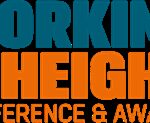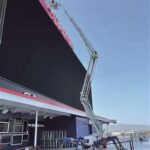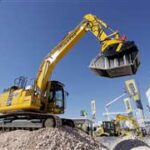You’re up there—30 feet, 50 feet, maybe even 100 feet in the air.
The view’s great, your harness is snug, and the next anchor bolt is just out of reach.
Naturally, you wonder:
“Can I just… drive a little closer without coming down?”
The short answer?
Sometimes yes—but only if you know exactly what you’re doing.
Let’s get into the rules of the high road.
⚙️ First: Is It Even Possible?
✅ Yes, many boom lifts are designed to drive while elevated—but there are conditions.
-
Manufacturer approval: Check your manual. Some models allow elevated drive, some strictly prohibit it.
-
Surface limits: Smooth, solid, level ground only.
-
Height limits: Some lifts restrict driving above certain heights (example: drive OK under 80 ft, lockout above).
-
Speed restrictions: You’ll crawl slower than a turtle—on purpose.
So while you might feel like cruising… you won’t be racing the Indy 500 up there.
📏 Typical Drive-While-Elevated Conditions
| Factor | Requirement |
|---|---|
| Surface | Firm, level, no potholes |
| Grade/Slope | Typically <3° tilt allowed |
| Wind Speed | Within rated maximum (often 28 mph or less) |
| Lift Model | Must be rated for elevated drive |
| Height Limit | Manufacturer-specified (eg. drive below 80ft) |
One bump, one pothole, or one gust of wind could ruin your whole day if you’re not careful.
🛠️ Which Boom Lifts Can Drive Elevated?
Modern models from top brands like Genie, JLG, Skyjack, and Haulotte often have drive-at-height capability.
Examples:
-
Genie Z-45/25J RT: Driveable at full platform height
-
JLG 600S: Can drive up to ~60 ft platform height
-
Skyjack SJ66 T: Allows elevated drive under safe conditions
Always, always, always read the specs before assuming anything.
🤔 Should You Drive While Elevated?
Just because you can doesn’t always mean you should.
✅ When it makes sense:
-
You need to move a few feet horizontally to continue work.
-
The surface is super smooth (like warehouse slabs or fresh concrete).
-
There’s absolutely no slope, holes, debris, or soft spots.
-
You’re trained, focused, and not rushing.
❌ When it’s a bad idea:
-
On muddy, gravel, or rough outdoor surfaces.
-
If wind speeds are picking up.
-
If you’re unsure about the lift’s stability.
-
If you hear that little voice in your head going: “Maybe don’t?”
That voice is called “common sense.” Listen to it.
🧠 Smart Operator Tips
-
Lower your boom as much as possible before moving.
-
Spotters help: a ground buddy can warn you of unseen obstacles.
-
Creep speed only: Drive as if you’re sneaking past a sleeping lion.
-
Re-check tilt sensors: Red lights = stop immediately.
-
Plan your work area: Try to minimize the need to drive at height.
Remember: Safe repositioning beats risky driving. Every. Single. Time.
🦺 What Happens If You Ignore the Rules?
-
Tilt sensors will lock movement.
-
Alarms will scream at you.
-
Platform controls may freeze.
-
Worst case? A tip-over—which could be catastrophic.
Boom lifts are marvels of engineering, but they obey physics.
Overconfidence at height is a one-way ticket to paperwork, injury, or worse.
🏁 Final Thoughts
So, can you drive a boom lift while it’s raised?
👉 Technically, yes—if the model allows it and conditions are perfect.
👉 Smartly, only when absolutely necessary and with maximum caution.
Think of elevated driving like crossing a narrow bridge in a sports car:
You don’t race across.
You creep, you check, you respect the limits.
In lifting—and in life—slow and safe beats fast and sorry.




